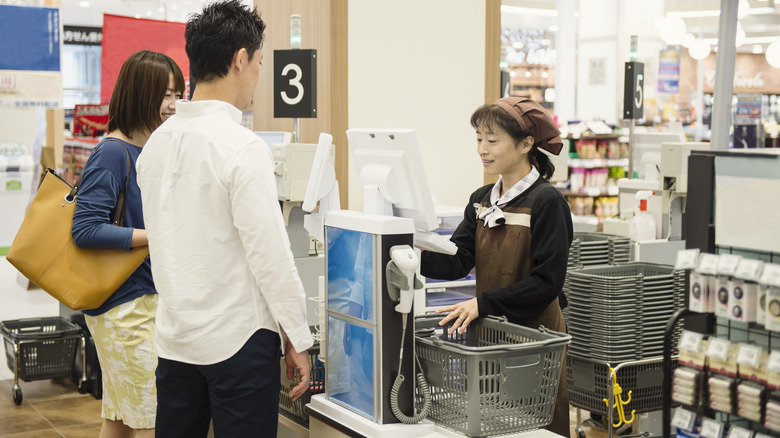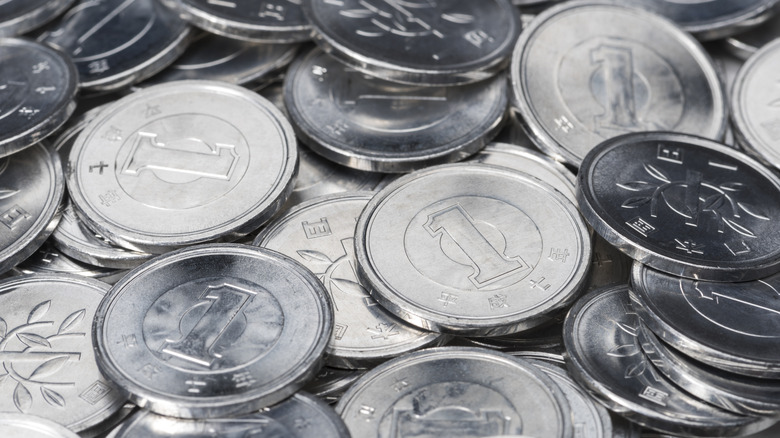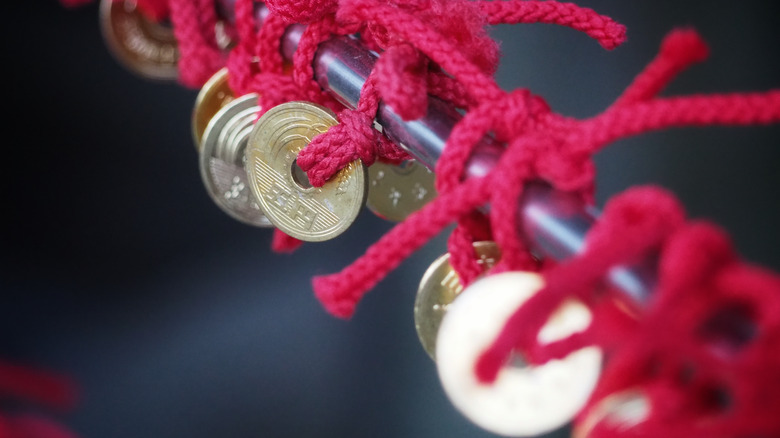Why It's Crucial For Tourists To Pay With The Exact Change While Visiting Japan
Fancy carrying a bag of money around? If you visit Japan and make most of your purchases with cash, you will undoubtedly have an assortment of coins in your wallet when returning home. Although foreign currency makes one of the best souvenirs (who doesn't like getting paid!), your wallet will be bursting at the seams. Since the end of COVID-19, Japan has largely started to go cashless for many transactions, though cash is still commonly used in rural Japan and even preferred by some due to greater privacy.
The Japanese yen is divided into 1, 5, 10, 50, 100, and 500 coin denominations. Some of these coins, 10, 50, 100, and 500, are widely accepted as forms of payment across Japan, whether purchasing a soft drink vending machine on the street, visiting a 100 yen shop, topping up your SUICA card in Tokyo, or buying an inexpensive snack from a convenience store. The lower coin denominations, 1 yen and 5 yen are, however, not commonly used as full forms of payment, apart from making change. Japanese people will often try to pay the last digit (paying 506 yen for something that costs 476 yen), to reduce the amount of small change, or will overpay (paying 1,200 yen when something costs 700 yen) to get one 500 yen coin back, rather than three 100 yen coins.
Unlike many countries that round currencies, when using cash at a restaurant, convenience store, or small kiosk, you will still get all of your small change in 1 and 5 yen coins, even if they are harder to use for purchasing items or services. Despite having little to no monetary value, both coins still have a historical and social value that can help visitors gain a greater understanding of Japan and its culture.
The small but mighty one yen coin
Japan is well known for its impeccable customer service which is focused on attention to detail and social etiquette. When shopping, this translates into the cashier giving you the exact amount of change owed when making a purchase–down to the very last yen, and normally placing them on a small, blue tray in an artful manner. Small, 1 yen coins may be 面倒くさい mendokusai, meaning "bothersome," however they are very much a part of the Japanese cultural shopping experience.
These coins (ichi-en dama) are minted from one gram of pure aluminium and have not been changed since they began production in 1955. The front of the coin has a large number one, with the era year while the reverse has a small sapling and is meant to symbolize Japan's growth. Although the monetary value of these coins has steadily decreased, and they are currently worth less than a penny, these come in handy when buying items in a Japanese convenience store or supermarket, as many food prices do not end with a zero.
Per Reddit, and my experience from studying in Japan, do not feel guilty taking a few seconds to count out the correct change when making your purchase. If your purchase costs 864 yen, you can pay for the entire transaction in coins, rather than breaking a 1,000 yen note, and likely no one will bat an eye. And, if you are trying to get the most out of your Japanese culinary experience, coins and cash payments are still the norm, especially in some of Japan's off-the-beaten-path hidden gems.
The lucky 5 yen coin
Japan's brass 5 yen coin (go en dama) is made from a copper and zinc alloy and has been minted in its current state since 1959. Although the 5 yen coin is also worth just a few cents, the coin is also highly prized for its historical and cultural significance. After Japan was defeated in World War II the country largely had to rebuild itself economically. When Japan's government designed the 5 yen coin, they integrated three envisioned pillars of Japan's economic rebirth within the coin: agriculture, the oceans, and industry.
The 5 yen coin is also prized by the Japanese as a symbol of good fortune and destiny, especially when praying at Shinto shrines before a major exam, a job interview, or for good health. In Japanese, the word for 5 yen (go-en), 五円 sounds very similar to (goen) 御縁, the word for fate, chance, or relationships. Save these coins for visiting shrines like the Japanese do. When praying, Japanese people will traditionally gently toss a 5 yen coin into the Saisen box for good blessings (or sometimes, multiple 5 yen coins for a greater blessing), though there is no amount you're required to give, and you are not required to. One more fun fact and trivia night answer: The five yen coin is the only Japanese coin to not have a standard number on it; it shows its value (五) in Kanji, the Chinese characters used in Japanese.
If you find yourself loading up on both of these coins and don't want to get a snack or a drink, you can normally donate them in a small box at the counter at a convenience store or near a McDonald's. Moreover, 1 yen coins make a cool souvenir or party trick, as they float if gently placed on the surface of water.


